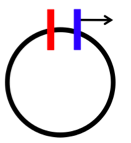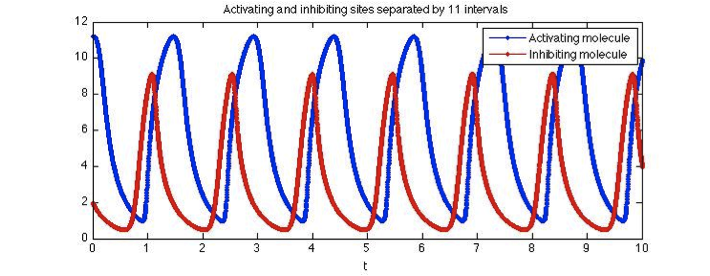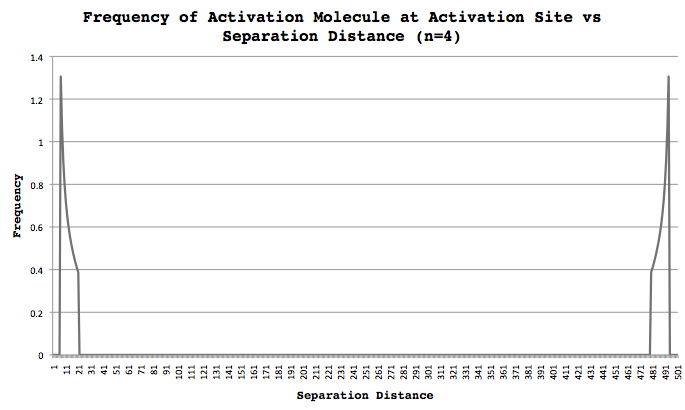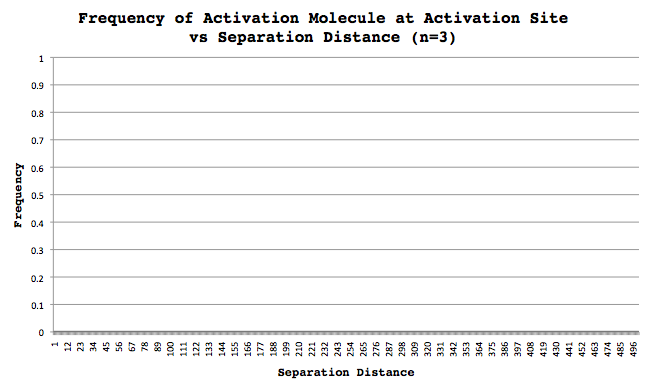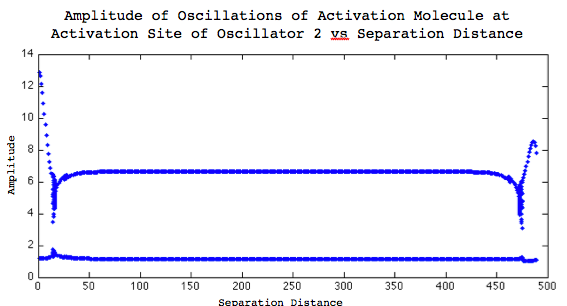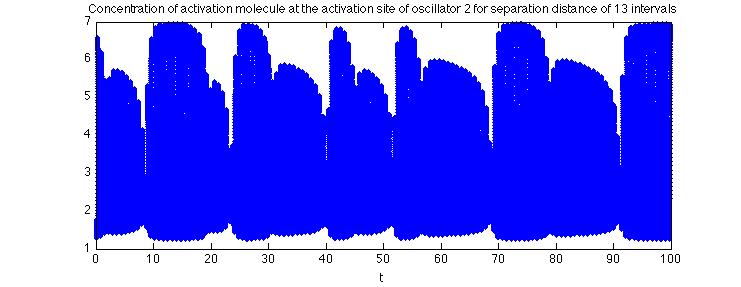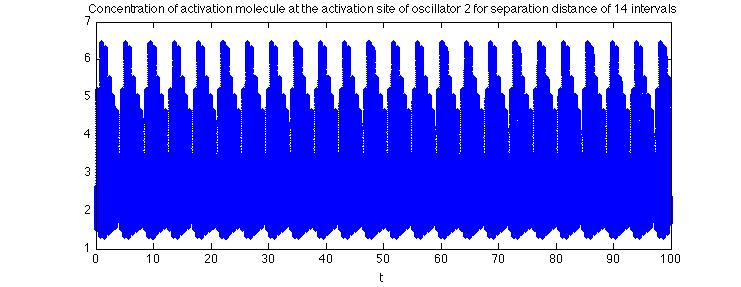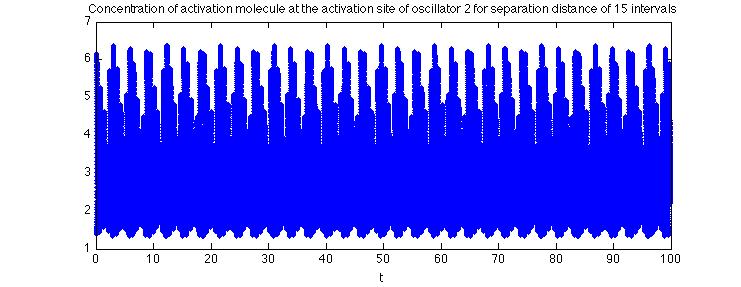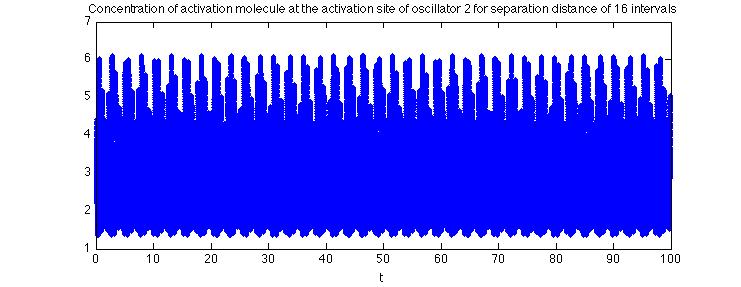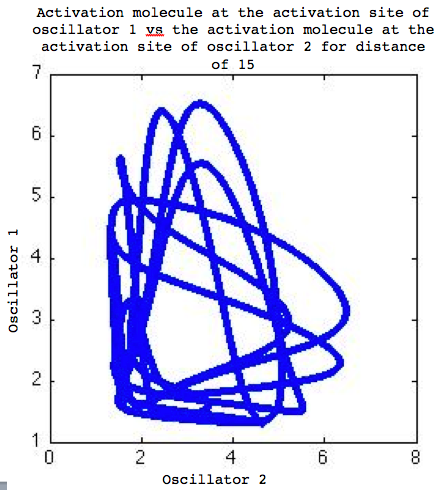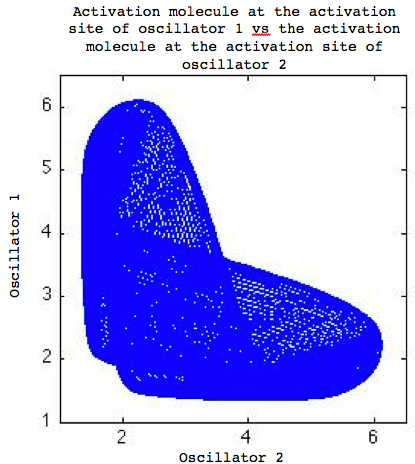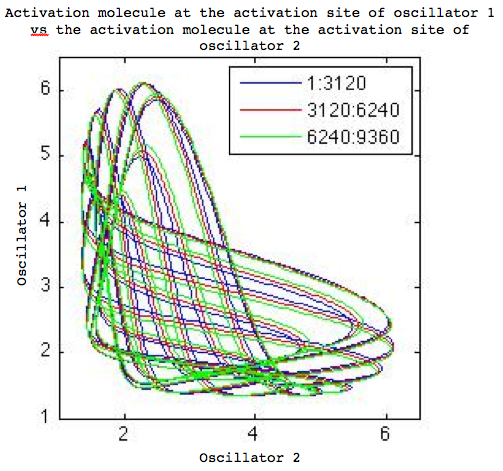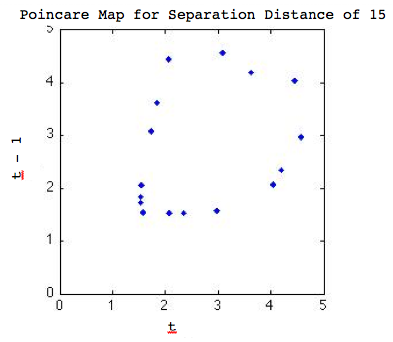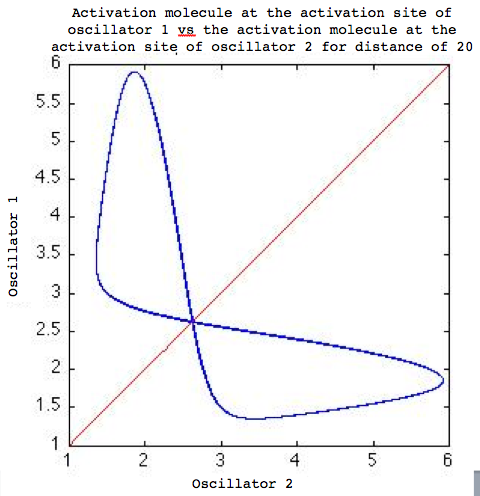Team:McGill/Modeling
From 2009.igem.org

The purpose of the following mathematical modeling is to gain insight into activation-inhibition signaling. We begin by describing the mathematical model employed to simulate our biological system. Then we examine the dynamics of one activation site and one inhibitory site, what we call an oscillator, and the effect of distance. We also examine the role two parameters, the Hill coefficient and diffusion rate, have on the oscillatory behavior. This leads to the next examination of two oscillators and the effect of varying the distance between the oscillators but holding the distance between the sites within an oscillator constant. Here we find several unexpected dynamics that we further explore. Finally we look into two dimensional modeling. However because of the size of the .avi files we will not discuss this modeling here but save it for our presentation at the Jamboree.
The following represents a brief overview of all of our modeling exercises. We unfortunately did not make use of this wiki throughout the summer and so many of our results have been left out for lack of time to upload. However, all of our results will be available on our poster and oral presentations at the Jamboree.
Contents |
Introduction
Many models examining intercellular signaling do not take into account the separation distances of the signaling bodies. We use a partial differential equation (PDE) based model to gain insight into spatially heterogeneous activation-inhibition intercellular signaling.
Two types of signaling molecules exist: activating and inhibiting. Each molecule is synthesized by a unique strain of cells and affects the synthesis rate of the other strain.
This is modeled using the following system of PDEs:
where Ψ1 and Ψ2 represent the concentrations of the activating and inhibiting molecules, respectively, γi the degradation constant, Di the diffusion constant, λi the maximal synthesis rate of molecule i, and δ the Dirac function. fi represents the Hill function describing the dependence on the opposing molecule:
where n, b, and θ are positive. To simplify the analysis, we chose equal parameters between the activating and inhibiting sites (Appendix A).
Numerical Simulation
The above system was solved numerically using a forward Euler scheme in time and a centered difference scheme in space. Cyclical boundary conditions were assumed; meaning the spatial dimension formed a ring. This was chosen since simulating an approximate infinite line is computationally costly. However, this also allowed us to investigate two site geometries during one simulation (explained later). The ring was given a physical length of 50 and discretized into 500 intervals. For simplicity, separation distances will be reported in terms of numerical intervals rather than physical distance.
One Oscillator
We first explored the different potential dynamics when the separation distance between an activating and inhibitory site was increased.
The following is an example of the dynamics observed when the two sites are at a distance where oscillations occur.
By analyzing curves similar to those in figure 3 the frequency of oscillations was calculated. Figure 4 illustrates the sudden appearance of high frequency oscillations when the sites are near each other and the decreasing frequency as they are moved apart until oscillations disappear.

The observation that the steady state becomes unstable for a range of separations has been reported previously by Shymko and Glass (1974).
Another way of looking at how oscillations depend on separation distance is by plotting the value of a curve whenever its derivative is zero vs the separation distance. This will also tell us some information on how the shape of the oscillations change with separation distance.
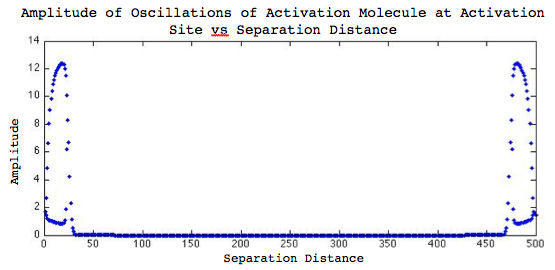
Notice the range of distances that have two values plotted correspond to the range of distances that have a nonzero frequency in figure 4.
One concern is that it is unlikely the chosen parameters are representative of the synthetic genetic network that we are constructing. The major parameter that we currently have no control over is the Hill coefficient n. We believe that if the Hill function is steep enough then the circuit will act as an on/off switch and oscillations are possible. Increasing n will only increase the steepness of the Hill function so we are safe in assuming that n > 8 will still lead to oscillations. However what is the smallest n that would still allow oscillatory behaviour? We calculated frequency for the range of separation distances with the following Hill coefficients n=2,3 and 4.
In order to observe oscillations we require a Hill coefficient of at least n=4.
We also looked into the dependence on the diffusion rate, D, and the presence of oscillations. As can be imagined, if the diffusion rate is too slow or too fast oscillations will not occur. This was confirmed with preliminary simulations where we found a particular separation distance that loses oscillatory behaviour if the diffusion rate is outside a critical range. We endeavoured to form a bifurcation diagram showing the ranges of separation distance and diffusion rate where oscillations occur, however this task is computationally intensive and we have not completed it as of this writing. We hope to have this result in time for the Jamboree.
Two Oscillators
We next looked at a system consisting of two oscillators, where each consists of an activation and inhibitory site.
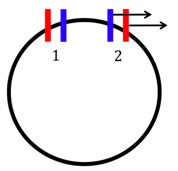
The distance between the two oscillators was varied while the distance between two sites within an oscillator was held fixed at 5 intervals. This value was chosen for demonstration purposes, however the dynamics to be described have been observed at various separation distances.
We first looked at the change in frequency as the oscillators are moved apart.
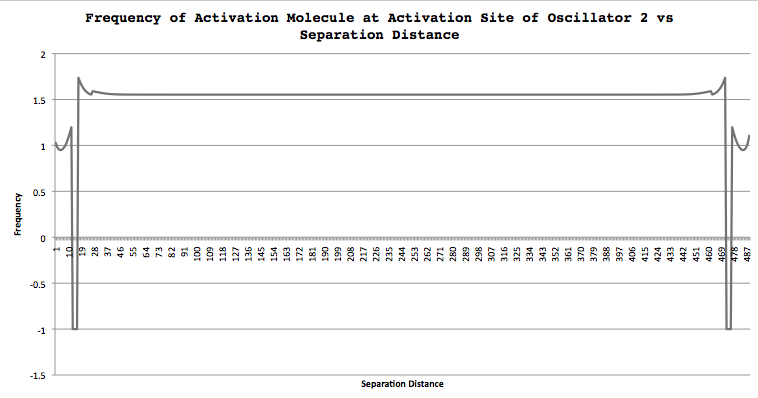
The first striking feature of this graph is the appearance of separation distances that have negative frequencies. The value of -1 is assigned to a separation distance that results in a complex oscillation whose frequency cannot be resolved using a simple method, which assumes simple periodic motion. Before we look into these curves, let's look over the entire graph. When the two oscillators are very close together, their frequency is always less than an isolated oscillator (look at figure 4 for two sites with a separation distance of 5 intervals). Interestingly, between the separation distances of 1 and 10 there appears to be a local minimum frequency. Meaning as the oscillators are moved apart, their frequency initially decreases and then begins increasing. This trend of increasing frequency continues until the numerical method calculating frequency breaks down. To get a better idea of why the frequency calculating method is not converging let's look at the amplitude of oscillations vs separation distance:
We can now begin to understand why the frequency calculating method failed. This method assumes simple periodic motion (similar to a sine or cosine wave), however the curves for which a frequency could not be calculated have more than 2 values where their derivative equals zero. This hints that they are not simple periodic curves. The following figure illustrates the concentration of the activation molecule at the activation site of oscillator 2 for the first distance that results in an oscillation whose frequency cannot be computed.
It is immediately obvious why the frequency measuring numerical method failed, the oscillations are far from simple. Before investigating this curve further, let's take a look at the other separation distances that resulted in complex oscillations.
The separation distances 474,475,476, and 477 resulted in similar dynamics and are not shown for brevity.
We first wanted to know whether these were truly the only separation distances that resulted in this type of dynamics. We recalculated the frequency of oscillations at each separation distance after simulating for 10,000 time units. In this way we hoped to overcome any transient dynamics and observe the true interaction. This resulted in the same set of separation distances having complex oscillations while everywhere else had regular simple oscillations. Furthermore, we recalculated the frequency of oscillations at each separation distance by using the final time point of the immediately preceding separation distance as the initial condition. We thought this would allow a quicker convergence to the stable limit cycle. However this also resulted in the same findings as before.
In order to further classify these dynamics as either aperiodic, quasiperiodic, or chaotic we must look further than the time evolution graphs. The phase plots begin to describe what type of oscillations are present. We plot the concentration of the activation molecule at the activation site of oscillator 1 vs the activation molecule at the activation site of oscillator 2.
Comparing figure 11 to figure 12 lets us believe that the oscillations in figure 11 are periodic while those from figure 12 are quasiperiodic. This is further illustrated in figure 13 where we can see that on each cycle there is a small shift in the oscillations, which is characteristic of quaisperiodic curves. In order to further investigate these dynamics we look at the Poincare maps of each curve.
Since the Poincare map of the oscillations present at a separation distance of 17 intervals leads to a filled in closed shape we are fairly confident that we have found quasiperiodic motion. Although the curve seen at a separation distance of 15 also looks quasiperiodic, the Poincare map does not form a filled in closed shape we can conclude that this separation distance leads to complex oscillations but not quasiperiodic.
The final analysis that we will perform on these simulations is to look at the phase lag between the two oscillators. We again move the second oscillator around the ring while measuring the phase lag between the activation molecule at the activation site of the first oscillator and the activation molecule at the activation site of the second oscillator.

A striking result of the phase lag calculation is that for some range of distances past the quasiperiodic forming distances, all the oscillations are exactly 180 degrees out of phase! A phase plot gives us more insight into these dynamics.
It is currently not well understood why a range of separation distances past the quasiperiodic curves remain 180 degrees out of phase.
Two Dimensional Modeling
We were able to further observe oscillatory behaviour in two dimensions, unfortunately the .avi files we have are too large to upload onto the wiki. This is all we have right now to describe our efforts into two dimensional modeling. We'll hopefully be describing them in detail during our presentation at the Jamboree.
Appendix A - Parameters
The standard set of parameters used to observe oscillations were taken directly from Shymko and Glass (1974).
γ = 2, D = 2, λ = 54, θ = 1, b = 0, N = 8.
Both strains were assumed to have identical parameters in order to simplify the model as well as explicitly observe the dependence of dynamics on separation distance.
 "
"



